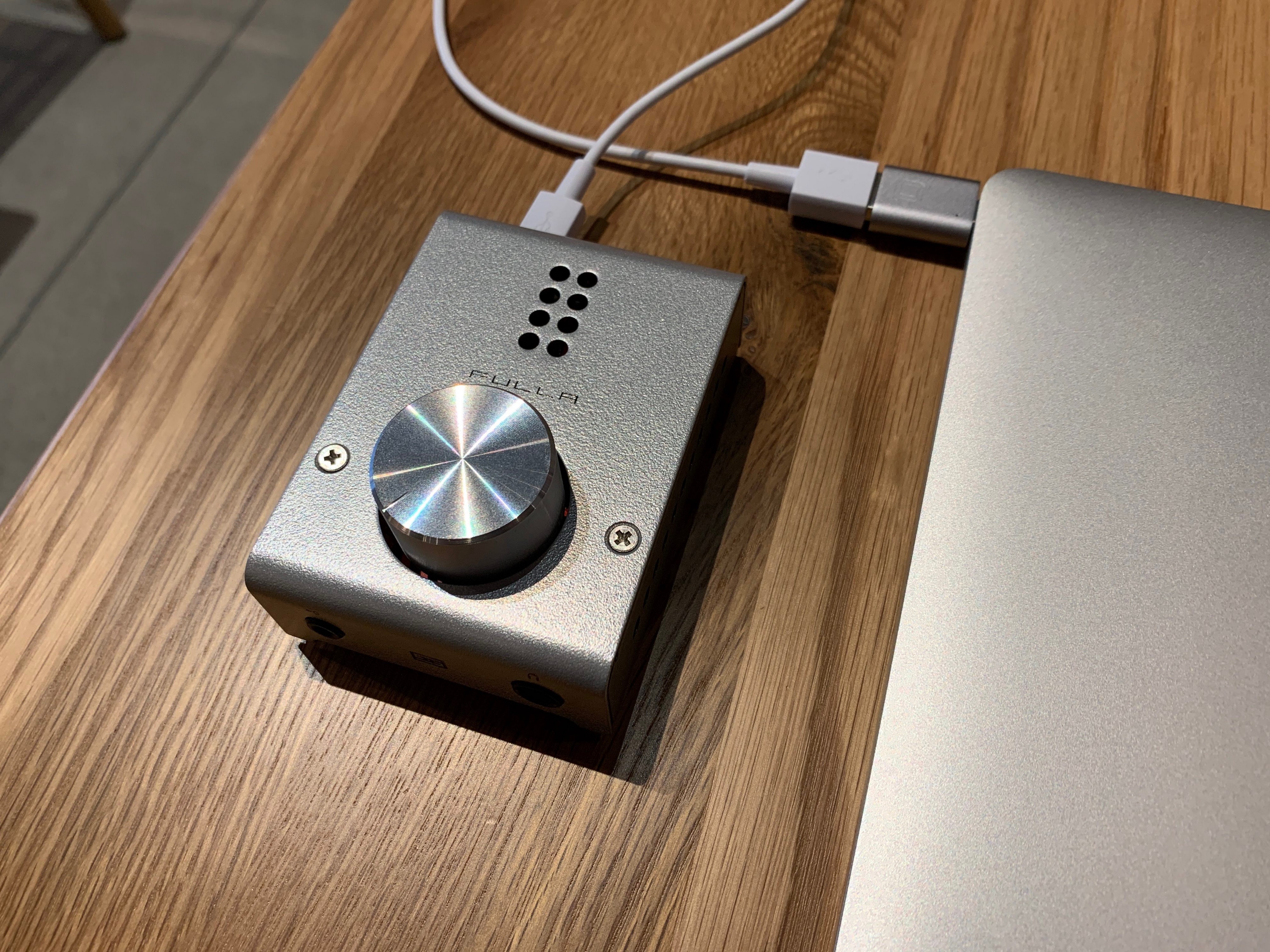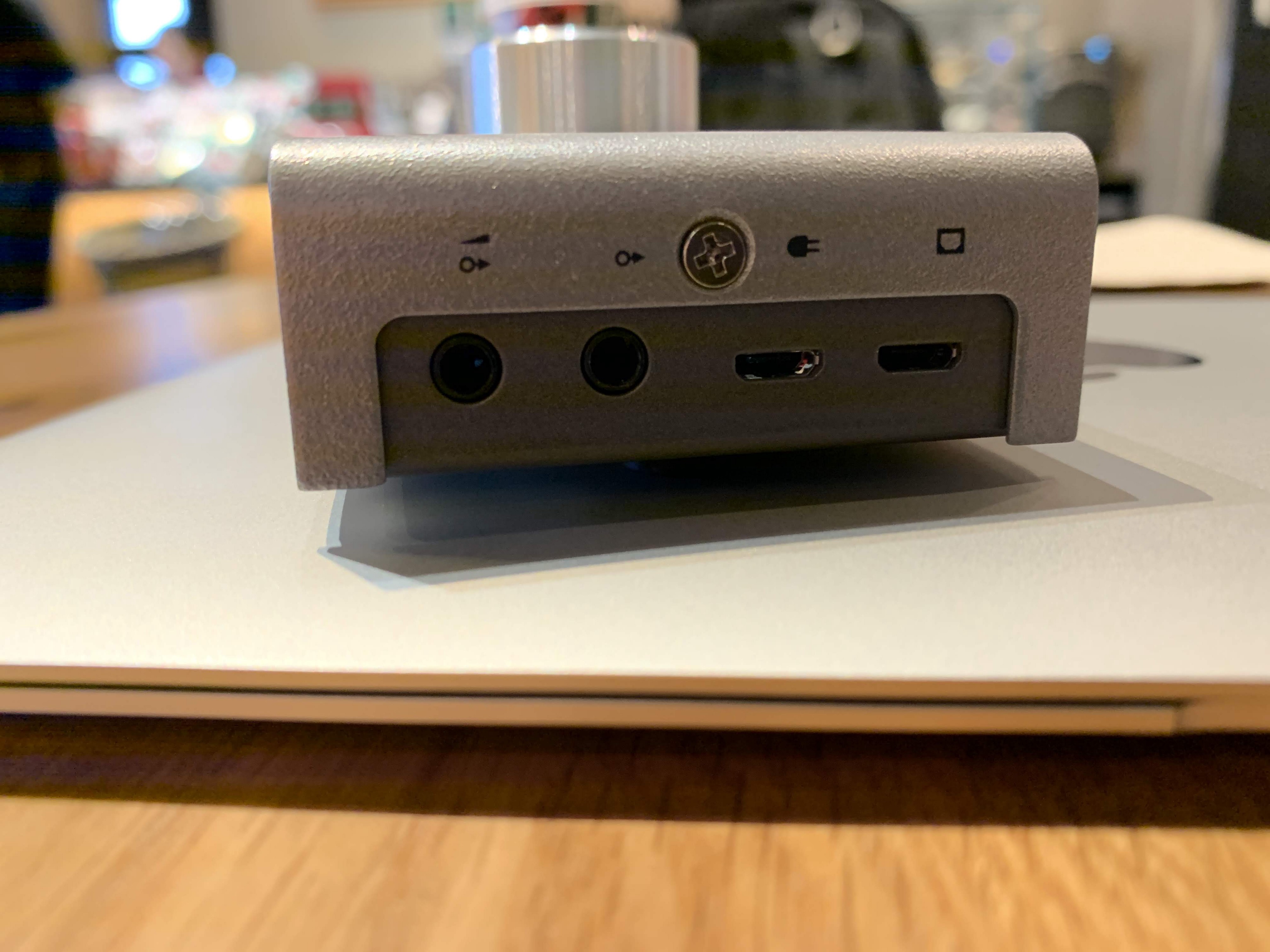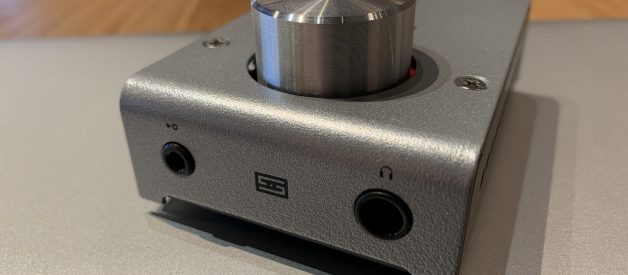A great portable box rides into the sunset
 The Fulla 2 looks great on top of a MacBook. Photo by Alex Rowe.
The Fulla 2 looks great on top of a MacBook. Photo by Alex Rowe.
I wrote my review of the original Schiit Fulla right after the unit was discontinued and on clearance, so it seemed fitting to do the same thing with its successor.
Ideally, solid state DACs and Amps shouldn?t be that much different from each other. The DAC should present audio that?s representative of the source file, and the amp should provide enough power for a wide range of headphones.
In spite of making threats to the contrary, I?ve never been much of an amp guy. I own four discrete headphone amps: a SoundBlaster E1, a SoundBlasterX G5, an Astro MixAmp TR, and the original Schiit Fulla.
The G5 is my standard desktop unit. It has all the ports I need, a low output impedance, and enough power to drive anything I?ve ever owned, including the 600 ohm DT880?s.
Unfortunately, it also has a nasty bug/glitch/habit. Sometimes, the digital volume control will randomly change the ?center? position with every volume step, meaning that as I turn my audio up or down it jumps all around in the stereo field. A quick unplug and replug of the USB cable fixes it, but it?s rather annoying when I have to do this more than once a day.
That glitch had me eyeing the Fulla 2 for a long time now, and at its new discounted price, I took the plunge. It?s a great little thing?though it has a few quirks of its own.
 The ventilation holes might seem like overkill, but the device gets just warm enough to benefit from them. Photo by Alex Rowe.
The ventilation holes might seem like overkill, but the device gets just warm enough to benefit from them. Photo by Alex Rowe.
OVERVIEW
The Schiit Fulla 2 is a fully integrated DAC/Amp combo, with a big satisfying analog volume knob on the top. It started at $99, but as of this writing it?s just $59 if you buy it direct, or around $20 more on Amazon, to account for their cut and the shipping.
I went the Amazon route because I?m a sucker for fast shipping.
On the front is a full-sized 6.3mm headphone jack, a rarity in small headphone amps. Next to it is a 3.5mm analog input for auxiliary analog input. The back side has two USB ports: one for your computer or other digital source, and one that just provides power in case your device can?t handle the power load on its own. Rounding out the back are a line level output and a second line out that?s attenuated by the volume knob.
That?s everything. There?s no buttons, switches, or indicator lights. It?s as plug-and-play as a device can be.
INITIAL TROUBLES
Upon receiving the unit, and enjoying both its snarky manual and humorous lambasting of the proposition 85 text on the box sticker, I quickly plugged everything in.
I shouldn?t have done this.
My SoundBlasterX G5 spoiled me. It will intelligently accept input from all of its ports at once, and auto-mute your speakers when headphones are connected. The Schiit Fulla 2 is a little more ?hobbyist? and thus less user-friendly.
I started out with my HDMI audio extractor box I use for game consoles connected to the front analog port through an RCA-to-3.5mm cable. What I didn?t know was that this would also automatically mute all input from the USB port.
I thought it was broken for a while?before I realized that part of the cost savings here is a total lack of smart switching circuitry. If you want to listen to both the analog input and the USB input over your headphones?you can?t.
Similarly, if you want your speakers or other line out device to mute when you plug in your headphones, then you have to plug the speakers into the volume-controlled jack. The other line out jack always outputs audio at all times no matter what you?ve got plugged in elsewhere.
These aren?t necessarily dealbreakers. The Fulla 2 isn?t really designed to be a multi-tasking device, and the internals you?re getting for the price justify putting up with these connectivity quirks.
 The Fulla 2 is a viable portable solution. Unfortunately, this cable from the HyperX Cloud Mix has a slightly curved tip, and doesn?t fully insert into the recessed jack. That?s why the cable is crooked here, so you?ll need a flat-tipped cable. Photo taken by Alex Rowe
The Fulla 2 is a viable portable solution. Unfortunately, this cable from the HyperX Cloud Mix has a slightly curved tip, and doesn?t fully insert into the recessed jack. That?s why the cable is crooked here, so you?ll need a flat-tipped cable. Photo taken by Alex Rowe
Those quirks extend to the design of the back panel jacks. Every connection on the Fulla 2 is marked with an icon instead of text, and while other reviewers seemed put off by this, I think the icons are intuitive.
However, the back panel connectors are slightly recessed and under an aluminum lip. So you?ll need compact, flush, standard size connectors to plug into them. That shouldn?t be a huge issue, and the included 3 foot USB cable fits just fine, but if you?re a fan of big custom cables, they might not work right with the Fulla 2.
SOUND REDEMPTION
Fortunately, once you?ve figured out that you need to unplug the analog in to listen to your PC audio, the Fulla 2 sounds exceptional.
I know that Schiit has a love-it-or-hate-it reputation among some folks in large part due to objective measurements. Their products don?t always stack up against the competition in the objective realm. But those graphs are also often exposing flaws that you won?t actually hear when using the device, making the argument more of an intellectual one than anything end users will have a problem with.
I?ve heard two Schiit products, and they?ve both sounded great to me.
I tested the Fulla 2 with a wide range of headphones, including the AKG K371, Beyerdynamic DT770 250ohm, and Grado SR80e. The volume knob is nicely balanced, giving me a good amount of headroom on the higher impedance DT770’s and a decent range of adjustment on the more sensitive models before my ears exploded.
There?s a tiny channel imbalance at the very bottom of the knob, but that?s common to most analog volume controls. Sound quality is clean and accurate, with a nice sense of staging. Honestly, it sounds nearly identical to my SoundBlasterX G5, but without the extra oomph that its high gain setting can provide.
That?s a good thing. Amps and DACs of a reasonable quality aren?t supposed to sound all that different from each other, and it?s the features that should make you choose one over the promises of mind-blowing audio.
I like the big volume knob on the Fulla 2. I like its no-nonsense plug-and-play design, even though the lack of switching circuitry threw me off initially. I like its compact size and robust metal frame. It?s small enough to throw in a bag and use at a coffee shop, but stable enough to be your main desktop unit.
The only complaint I?ve had so far sound wise is that when using the DT770?s in conjunction with the 3.5mm input connected to my HDMI audio extractor, the volume is a little quiet. My HDMI box doesn?t have any sort of gain or pre-amp applied, and the Fulla 2 doesn?t apply any extra gain either, so the power-hungry headphones don?t get quite enough volume compared to my old G5.
 Most sub-$100 audio devices don?t have this many connection options. Photo taken by Alex Rowe.
Most sub-$100 audio devices don?t have this many connection options. Photo taken by Alex Rowe.
THE FUTURE
Interestingly, both the Fulla 3 and the more-expensive Hel have solved a lot of my complaints with the Fulla 2. They both have more output power, with the Hel offering up a huge boost thanks to a required power brick. They both have a little more room around the rear input jacks. And they both ditch the output port that wouldn?t mute when you plug your headphones in.
Both of the newer models specifically target PC gamers, meaning they have dedicated microphone jacks. The Fulla 3 regrettably loses the 6.3mm headphone input, but the Hel keeps it.
The Hel also gets a gain switch and an input mode switch, two great convenience features that the Fulla 2 sorely lacks.
FINAL THOUGHTS
The Schiit Fulla 2 pairs wonderful audio performance with a nice volume knob, and a good collection of inputs for such a tiny device. It?s not completely perfect, but its quirks are acceptable at this price. Although I don?t have to reconnect it to get the volume knob to work like on my old G5, now I have to plug in the analog audio source when I want to use that, and unplug it when I?m done.
I traded one cable I have to switch for another.
The newer models are more competitive with the current headphone amp market, but the $59 closeout price the Fulla 2 goes for is a phenomenal deal. It probably doesn?t have enough output power for the very hardest to drive headphones, but it?s a much better entry point into the Schiit family than the original Fulla was.
I?ll probably buy a Hel before they?re discontinued.


